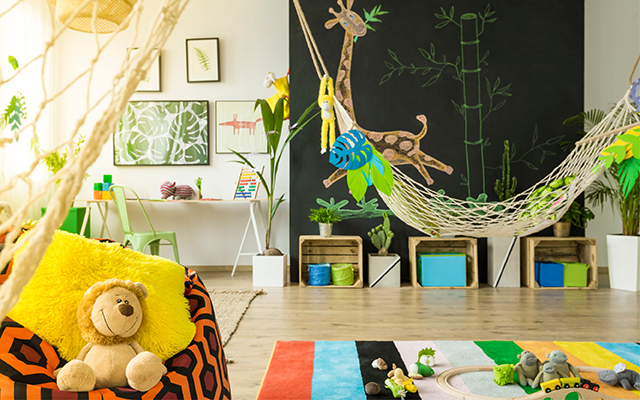If you want to know whether someone has ADHD, visit their home. People with attention-deficit/hyperactivity disorder are notoriously messy. Everything — and we mean everything — is left in the open. “If it’s not out in the open, it’s forgotten,” explains Sarah Kidder, an interior designer who has the disorder.
Why? According to Elaine Taylor-Klaus, parent coach and cofounder of ImpactADHD, “people with ADHD often organize by field of vision.” That’s because a common attention-deficit symptom is low working memory: If an ADHDer can’t see something, they forget they have it. That means bills strewn across the counter to ensure they get paid and sweaters tucked in dresser drawers that never get worn. “We have to find a way to keep things visible without crossing over the boundary into completely cluttered,” Taylor-Klaus notes. “It’s a delicate balance.”
But an attention-deficit diagnosis doesn’t have to mean an eternally cluttered home. Small changes in decor can make a big difference — not just in appearance but with keeping symptoms in check. With that in mind, an ADHD expert and three professional designers share their suggestions for a more attention-deficit-friendly home:
1. Fewer drawers, more shelves.
“There is a tendency for people with ADHD to avoid the motor piece of putting something away,” says Taylor-Klaus. Neurologically, the ADHD mind has a hard time focusing on the mundane. Depending on an individual’s brain chemistry, dopamine and norepinephrine, the neurotransmitters that regulate focus, are missing or in short supply. The result is those with the disorder often complete vital parts of a task, but leave finishing details undone. At home, this means cabinet doors and dresser drawers left open and objects that are never put away. “It’s boring, tedious, [and] annoying to have to open up a drawer, find the folder, and put something inside — so we put the receipt on the counter,” says Taylor-Klaus.
To cut down on clutter, trade in traditional cabinets for the kind with clear fronts. Place stainless-steel hooks on bathroom and kitchen walls in an attractive pattern, then use them to hang the items that never make their way into drawers, like your hair dryer. Shift clothes from dressers and chests to wardrobes or chifferobes where they can be more readily seen. For sweaters, try one-layer deep, open-front shelving.
2. Writing on the wall.
Kidder says, “Many people with ADHD have an ‘out of sight, out of mind’ mentality.” That’s why there are so many scraps of paper scattered around an ADHD home: People with the disorder start lists just to set them down, forget about them, then make new lists. Instead of keeping up with Post-it notes, Kidder recommends painting a kitchen or office wall with whiteboard paint: “[The wall] will help to provide visual clues about upcoming appointments, due dates for bills, or lists of groceries to buy, birthday party gifts to pick up, or things to repair around the house.”
But don’t scribble your to-dos on the wall willy-nilly. Make it pretty! “People with ADHD tend to be creative,” Kidder says, so put that creativity to use and mimic the chalkboard trend currently popular in coffee shops. Use black paint and white markers. Sketch out beautiful headings to show your own personal flair. Then when you leave for errands, Kidder says, “Snap a picture with your iPhone” and you’re all set.
3. More is less.
Interior designer Lisa Kahn doesn’t have attention-deficit, but her daughter does. To help with hyperactivity, Kahn worked with her doctor to make their home a sanctuary free from auxiliary stimuli. “When [my daughter] can be calm, then her focus follows,” Kahn says. That’s why she advises “soft, tactile products . . . for example, a really soft rug or a soft upholstery on a chair or throw. Running your hands over soft surfaces is soothing and calming. Think of the way petting a dog lowers blood pressure.”
Just keep it under control. “A room filled with furniture, paperwork, [or] accessories can be an overload to a busy mind,” cautions designer Dawn D. Totty, who says streamlining accents in “a monochromatic color scheme” will minimize distractibility. Toile wallpaper and textured ceilings are also a no-no. People with attention-deficit, prone to hyperfocus, may lose themselves in the design, analyzing every detail.
Remember . . .
The most important part of your home is you — and the people who share it. ADHD-proofing your house “gets more complicated when there are multiple people sharing a space,” says Taylor-Klaus, “I was able to organize myself quite easily when I was single and living alone, but it got more complicated when I added a spouse with ADHD to my world, and then went into overdrive once I added kids and all their stuff!”
Be considerate about the kind of home your whole family wants. Yes, a wardrobe is more manageable than dresser drawers, but if that dresser belonged to your husband’s grandmother, good luck getting rid of it. Maybe your teenage daughter doesn’t want visiting friends to see her mother’s lists all over the wall. ADHD-proof as much as you can, but remember a happy home is the healthiest one — attention-deficit or not.




This Post Has One Comment
People with attention-deficit, prone to hyperfocus, may lose themselves in the design, analyzing every detail.
totally agree… I am right now trying to find a dresser that would be good for my fiance who has this… I saw that you also said auxiliary stimuli… and soft textures or monotone colors
I am wondering if you have any suggestions on furniture?
I was thinking lots of drawers…. but I feel like simple may be better?